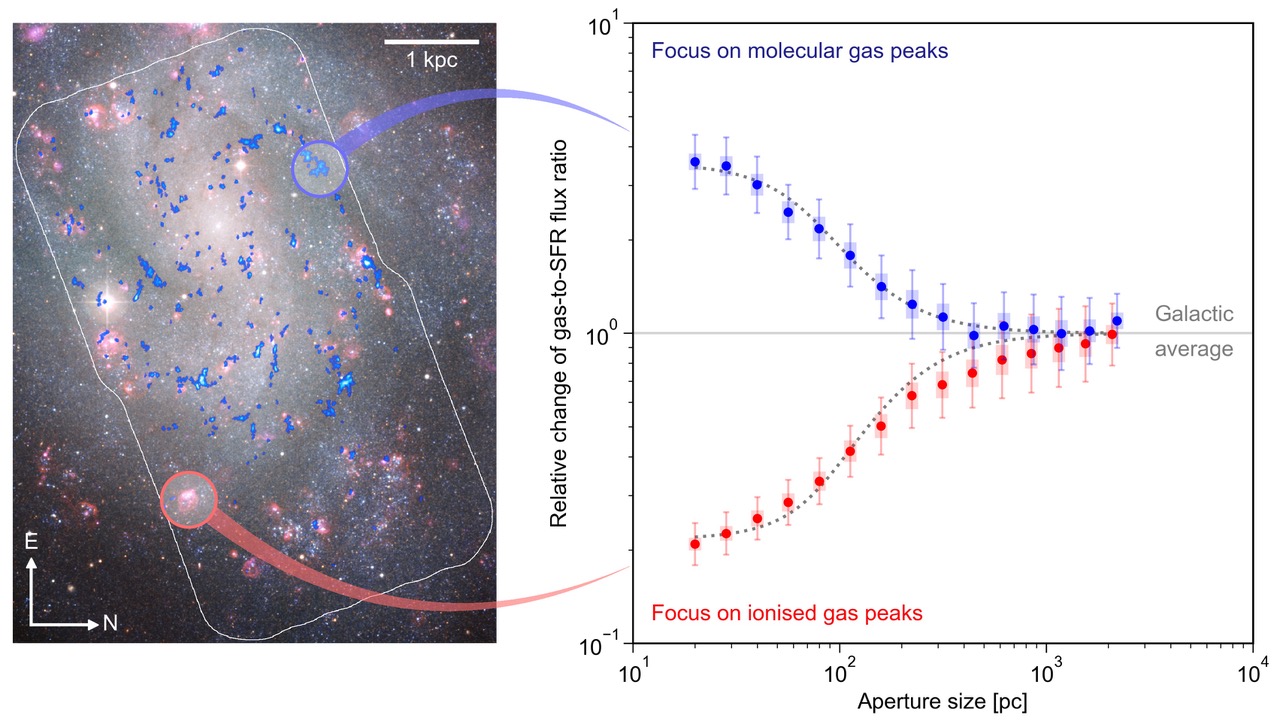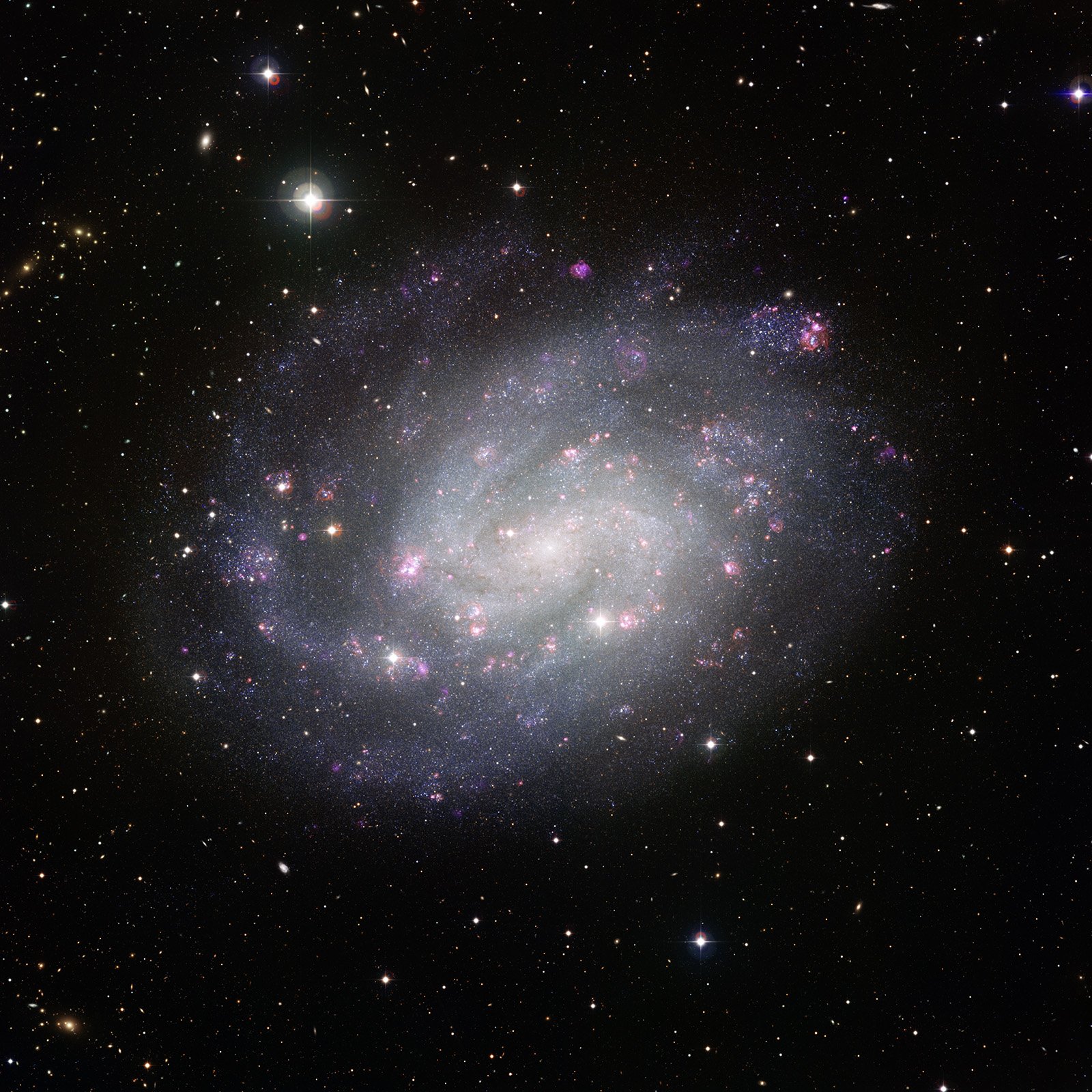Star formation within interstellar gas clouds proceeds very rapidly, yet highly inefficiently. Most of the gas is quickly dispersed by stellar radiation, revealing galaxies to be highly dynamic systems, like “cosmic cauldrons”, consisting of building blocks that constantly change their appearance. A team of scientists led by astrophysicist Dr. Diederik Kruijssen from Heidelberg University has come to these conclusions based on new observations of the spiral galaxy NGC300.
It is one of the main unsolved problems in astrophysics to determine the physical mechanisms driving star formation. A team of scientists led by astrophysicist Dr. Diederik Kruijssen from Heidelberg University has now managed for the first time to reconstruct the time-evolution of interstellar clouds of gas and dust, so called molecular clouds, and the star formation process within them. Using new observations of the spiral galaxy NGC300, Dr. Kruijssen and his team were able to demonstrate that star formation proceeds very rapidly, yet is highly “inefficient”. Most of the interstellar gas is not converted into stars, but is instead dispersed by stellar radiation. Their analysis shows that molecular clouds are short-lived structures undergoing rapid lifecycles, driven by the intense radiation from the new-born stars within them. This finding shows that galaxies are dynamic systems, like “cosmic cauldrons”, consisting of building blocks that constantly change their appearance.
The observed intensity of star formation in the spiral galaxy NGC300 can be explained in two ways. Molecular clouds may be very long-lived, and eventually convert all of their mass into stars. In this case, the positions of young stars should generally match those of the molecular clouds from which they formed. Alternatively, stars may form very rapidly within molecular clouds and disperse the gas with their intense radiation, causing only a small fraction of the gas to be converted into stars. In this case, emission from young stars and molecular clouds should generally reside in different locations, because the short period over which star formation takes place means that young stars within molecular clouds would be a rare sight.
To answer which of these models for the molecular cloud lifecycle is correct, Dr. Kruijssen and his team combined two different sets of observations of the galaxy NGC300. The first is a map of light emitted by carbon monoxide, which shows where molecular clouds reside. The second is a map of hot, ionised hydrogen, which marks the positions of massive stars that just formed. These maps were obtained with the Atacama Large Millimeter Array (ALMA) of the European Southern Observatory (ESO) and the 2.2-meter telescope of the Max Planck Society and ESO. The scientists then analysed the data using a new statistical method, which determines how molecular gas and star formation in galaxies are related on different spatial scales. For the first time, this method enables to precisely quantify the positions of molecular clouds and young stars relative to one another.

The results left no doubt: molecular clouds and young, massive stars rarely coincide. This effect becomes stronger on smaller scales. The researchers conclude that stars form and destroy their parent molecular clouds very rapidly, such that gas and young stars represent distinct, subsequent phases in the lifecycle of molecular clouds. “Our results demonstrate that star formation proceeds very rapidly and highly inefficiently”, explains Dr. Kruijssen. “Molecular clouds in NGC300 live for about ten million years, and take only about 1.5 million years to be destroyed, well before the most massive stars have reached the end of their lives and explode as supernovae.” Dr. Mélanie Chevance, researcher in Dr. Kruijssen’s team and co-author of the paper, adds: “The intense radiation from young stars disperses their parent molecular cloud by heating them and blowing hot bubbles of interstellar gas. This way, only two to three percent of the mass in molecular clouds is actually converted into stars.”
The team of researchers now wants to apply their new statistical method to observations of very distant galaxies, to infer how star formation in molecular clouds proceeds across the history of the Universe. “We will now proceed to investigate the relation between molecular clouds and young stars in galaxies throughout the cosmos. In the near future, this will allow us to understand galaxies as collections of building blocks that each undergo vigorous, star formation-driven lifecycles and together shape the appearance of their host galaxies”, describes Dr. Kruijssen.
